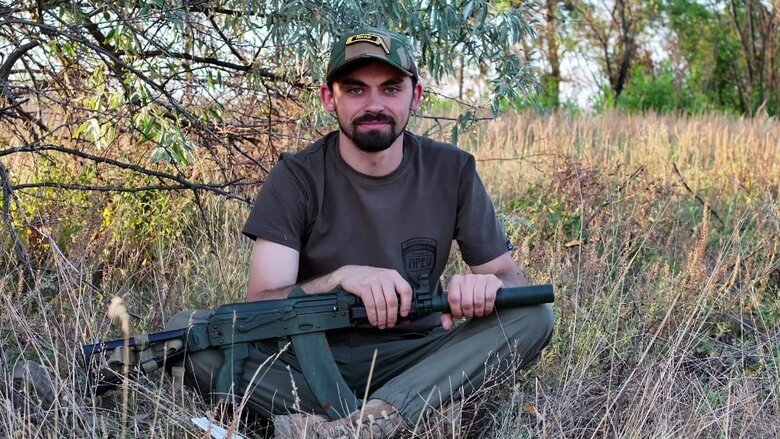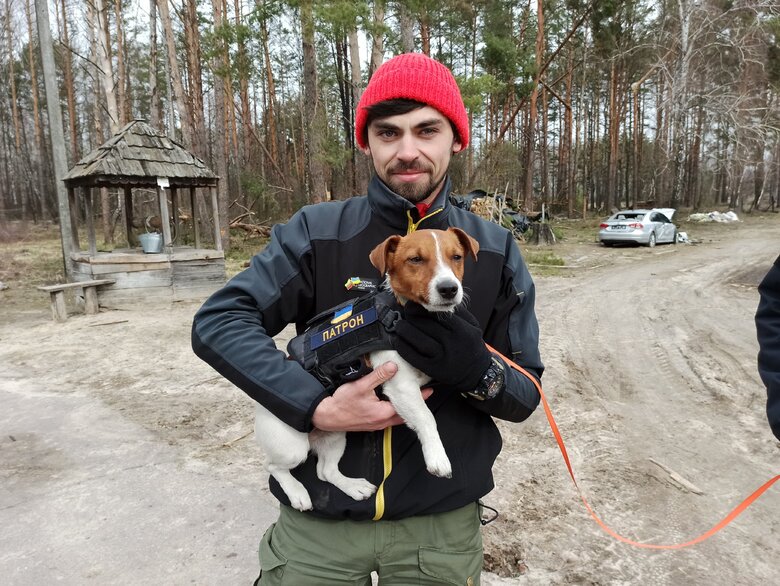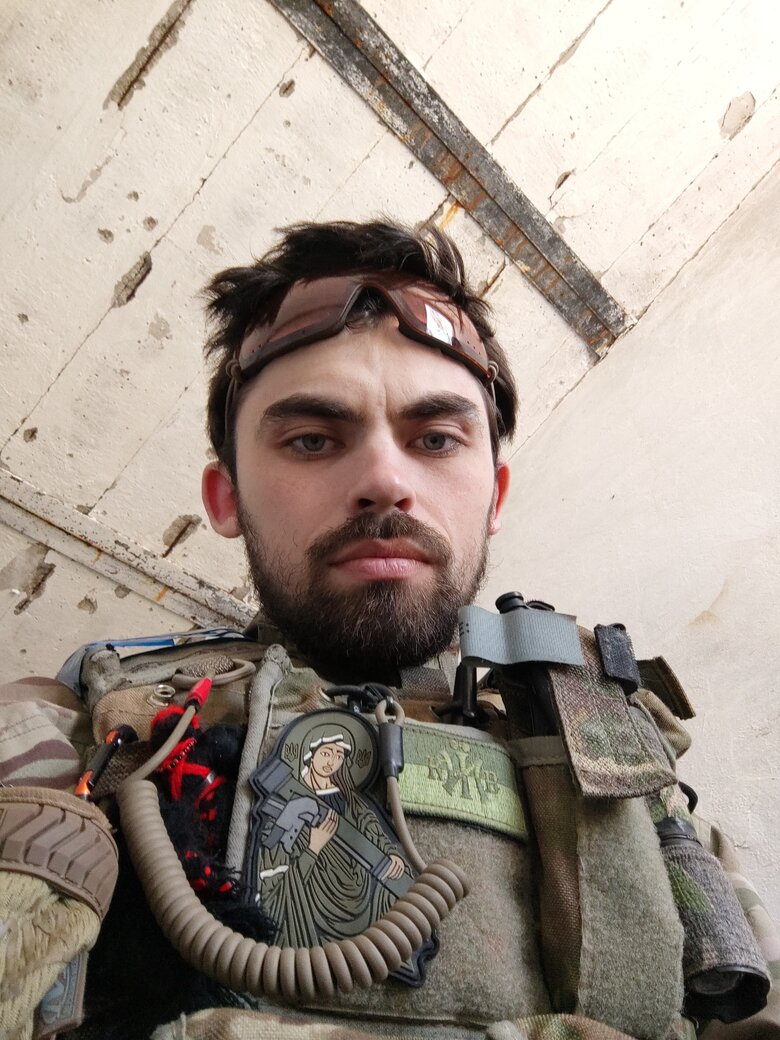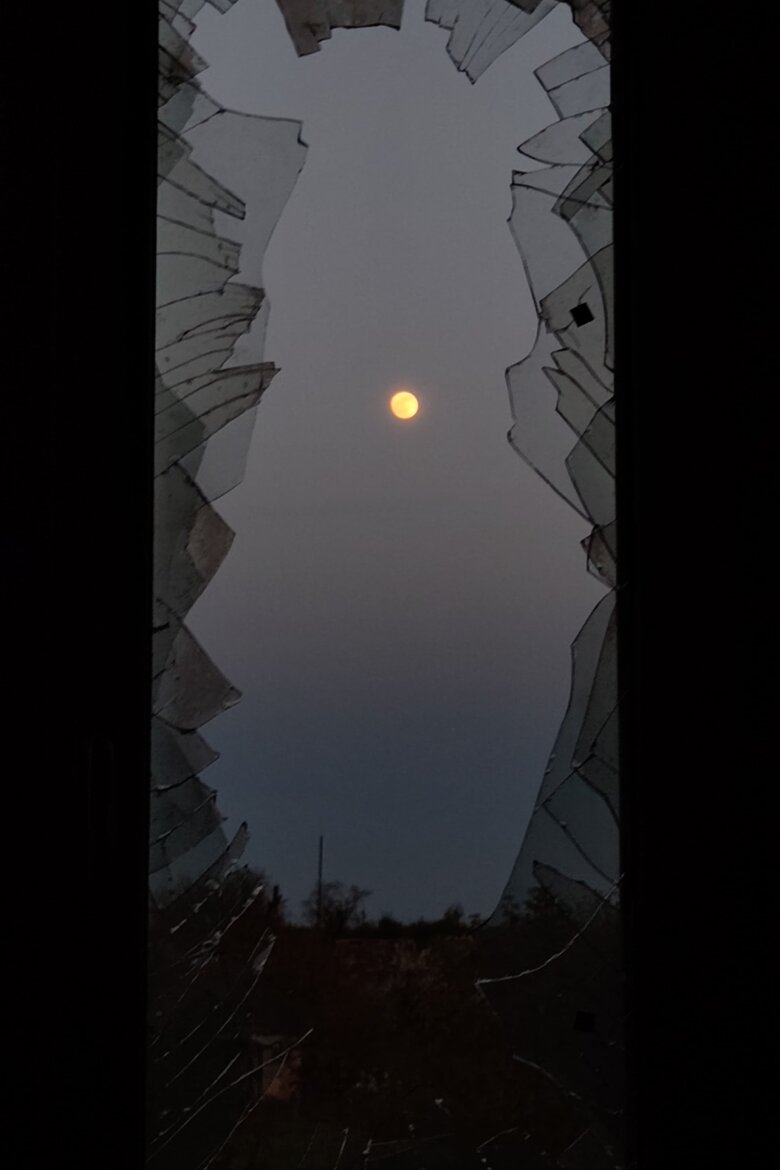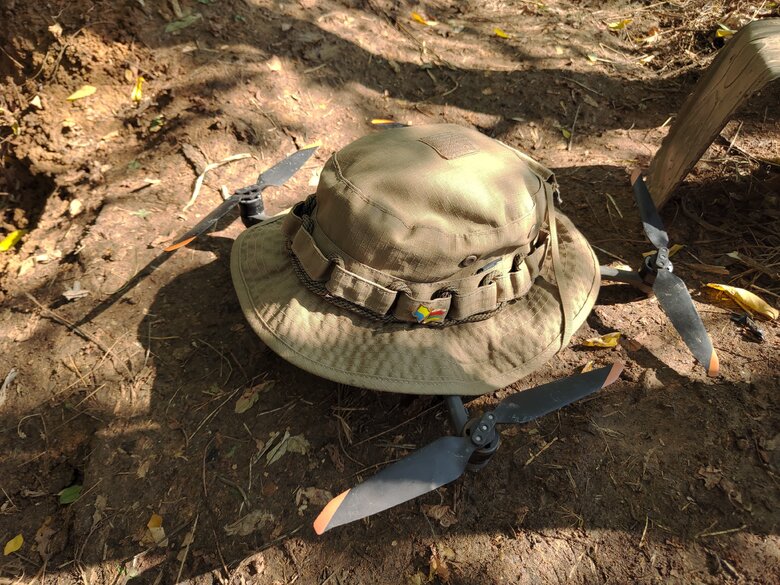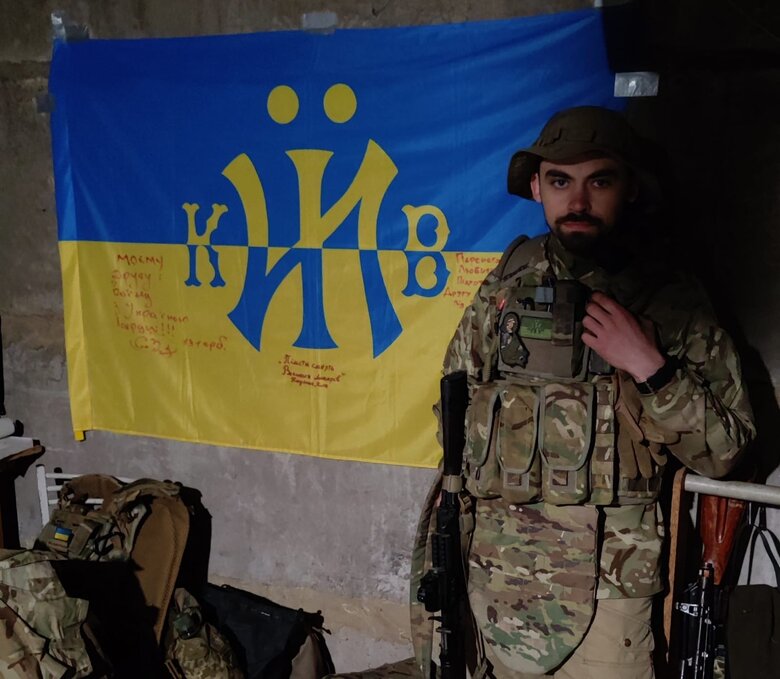Call sign "Panama": "In Kursk region, there were companies of wounded Russians sitting in trenches without water, food, or proper ammunition"
"You could say that people like me were recruited through the announcement," Vitalii jokes. His call sign is Panama, and he’s recalling how he joined the army in May 2022.
At the time, it was difficult to join official military structures. While scrolling through social media, I came across a post about recruitment to a volunteer battalion. That’s how I ended up at the training center of the Ukrainian Volunteer Army.
Today’s interviewee is a UAV operator and instructor with the Arei Assault Battalion. In civilian life, he worked as a process engineer and designer at various companies, some of which were linked to the defence sector. There he picked up valuable skills in process organisation and task planning. As early as 2021, he reasoned that Russia might launch a full-scale invasion, so he prepared: on weekends he attended military training courses in Kyiv, bought gear, and tried to enrol in the Territorial Defence Force, which was still being formed at the time.
- "Since Ukraine regained its independence, the Russians have been trying to break us politically," he explains, spelling out the logic behind his decisions. "The events of 2004 and 2013 showed them that this would not work. They therefore came to view force as the only way to ‘solve the Ukrainian question’—and they failed at that as well. You can see it when you look at their broader strategic goals. Now they are shifting back to the political arena again, trying to apply pressure not through divisions inside Ukraine but through fault lines abroad."
- You mentioned preparing for a full-scale war. How did it begin for you?
- Things didn’t go as planned. I ended up facing the war without any of my gear, even though I had prepared for it. I didn’t even have my documents on me! The day before the invasion, I had gone outside Kyiv to help my parents renovate their house. For those first few days, I was basically a "prisoner" (he smiles – O.M.), unable to go anywhere. As soon as I had the chance, I started volunteering locally — helping organize evacuations from the Chernihiv region and distributing humanitarian aid. Almost immediately after the area was liberated, I went to villages near Chernihiv to assist. Initially, I thought I’d be helping with logistics but it turned out I was more needed for exhuming the bodies of civilians and documenting war crimes. That was in the village of Yahidne — the one the Russians had turned into a 'concentration camp'. That was the moment I knew for sure I had to join the military. As I mentioned, getting into the regular army was very difficult at the time — the influx of volunteers was overwhelming. So I joined a volunteer unit instead.
- How were you received?
- It was a bit like the Zaporizhian Sich. Since it was a volunteer unit, no one forced you to stay — but if you planned to, you had to prove you were ready for war and complete full training. It was fascinating because people came from all walks of life, with all kinds of backgrounds and personal histories. Some had combat experience, others had just turned 18. There were some great guys there! I still keep in touch with many of them, even though we’ve all ended up in different units.
- Where did you go after training?
- At first, I joined the 5th Separate Battalion of the Ukrainian Volunteer Army. In the summer, I did some work in the Kharkiv region with a mortar group, serving as a UAV operator and fire corrector. Later, that same team transitioned to Arei.
- So you were already flying missions in the summer of 2022?"
- Yes. In the Ukrainian Volunteer Army, everyone is initially trained as an assault trooper — that’s the mandatory foundation. Only after that are you assigned a specific role. Physically, I was best suited for UAV operations" (smiles – O.M.).
- Were you flying Mavics?
- We started out with Mavics and Autels. That’s what my teammate and I got assigned to — and stuck with. So from that point on, I was with Arei. I only managed to sign an official contract in January 2023.
- Why is that?
- Bureaucracy. I was too young.
-How old were you?
- Twenty-six. But at the time, contracts were only signed with those 27 and older. In the end, we sorted it out.
- You were in the Kharkiv region in the summer of 2022, just before the counteroffensive. Were you involved in preparing it?
- We helped set it up — and then missed it, (laughs – O.M.), because we had to leave to sort out our paperwork. But we worked closely with the guys from the 92nd Brigade, who later went on the offensive. We were operating in the areas where it all began.
- So would you say that’s where the real war began for you?
- Yes, these were my first combat flights.
- What stands out most in your memory from that time?
- The people around me left the strongest impression. It was a crew of guys who’d been at war for a long time—charged-up, upbeat. They had just driven the katsaps (Katsap is usually described as an ethnic slur for russians - ed.note) back from Kharkiv. And there I was, green as grass, clueless. I just tried to do whatever they told me: adjust your chest rig, grip the rifle right, keep your arm inside the pickup so a branch doesn’t tear it off. Thousands of little details like that stick with you. When you work alongside professionals, you learn fast."
- What was your first combat UAV mission like?
- The task was to fly the drone and spook the katsaps sitting in the treeline across from us" (smiles – O.M.), hoping they’d give themselves away — maybe start shooting or something.
- Did it work?
- Not really, (laughs – O.M.), but it is what it is. After that, I moved on to reconnaissance flights.
- When did you switch to drone-drop missions?
- That came later, with Arei during the 2023 counter-offensive. Earlier, our unit’s main job was adjusting mortar fire. We had plenty of rounds, the guys were well supplied, and we worked extremely efficiently. I could adjust artillery, mortars—several fire assets at once. It worked really well. We got a ton of work done: we "ground the katsaps down" near Neskuchne during counteroffensive. They had nothing good to say about our mortar crew afterward.
- The 2023 counteroffensive didn’t turn out as successful as many had hoped, partly due to delays in weapons supplies from our international partners. And yet there were high expectations riding on it. What was your state of mind back then?
- Honestly, I didn’t even realize it had started — it got intense, but no one really warned us that this was the beginning of the counteroffensive (smiles – O.M.). Still, we adapted quickly, figured out what was going on, and got to work. Three days later, we were launching assault operations ourselves. We liberated Neskuchne fast, with minimal losses on our side and heavy ones for Russia. Then we pushed further, retook territory all the way to Staromaiorske and the surrounding areas. During that push, we, together with adjacent units, made one of the deepest penetrations and performed extremely well. What that axis really needed next was more units to be thrown in to smash the Russian defensive lines for good.
By the way, back in 2022, the battalion also took part in the liberation of the Kherson region. That shouldn’t be forgotten — the guys did a huge amount of work there as well. I missed most of that phase because I spent a lot of time on bureaucratic trips while my paperwork was being processed.
- But you caught up after that.
- We did. We proved ourselves during that time. After the counteroffensive, we were brought in to help repel a Russian assault near Vovchansk. We performed well there too — secured the eastern flank and managed to stop the enemy. After that, other units moved in to hold the line.
- Everyone I talk to in the military keeps repeating the same thing — never underestimate the enemy. They’re learning and evolving too. How do you see them?
- It’s true — they’re capable of learning quickly and adopting effective tactics and tools. But that’s not enough for them to achieve their ultimate military objectives. They're still struggling. Their resources aren’t unlimited. You can clearly see that from how they constantly have to look for shells in other countries and rely on outdated equipment for assaults, because they can’t replenish fast enough. They do have far more manpower than we do — and that’s something you can definitely feel.
- That’s why they carry out these so-called 'meat assaults', throwing soldiers into battle without regard for losses. Just recently, the commander of 'Rarog', Khasan, told me he was stunned to see a Russian infantryman on crutches taking part in an assault. Have you seen anything that surprised you like that?
- Actually, stories like that are quite common. The Russians even have units made up of disabled soldiers. We saw all sorts of things in the Kursk region. There were companies of the wounded sitting in trenches without access to water, food, or proper ammunition. But they still held those positions so that more or less intact assault troops could use the sector as a staging ground for further attacks. It was a miserable crowd of maimed Russians, drinking from puddles—some of them even swam across a freezing river to flee. I guess they were just that desperate. And this was in the snow, in sub-zero temperatures.
- Did he make it across?
- I saw tracks leading into the bushes on the other bank. We had just hit their group. One Russian hid under an armored vehicle to hide. Then he came out, walked up to the river, looked around, slung his rifle over his shoulder, and started swimming. At first, I thought he’d drown — he kept thrashing around in the branches for a long time. But he eventually made it out. I don’t know if he ever got back to his own lines, but he did manage to cross the river.
There was also an incident in our sector where they finished off their own WIA (wounded in action - ed.note) who had spent nearly a full day crawling toward our lines, trying to surrender.
- How did they finish him off? With a drone?
- Yes, they killed him with a drone-dropped munition. The episode was caught on video. (On 11 January this year, media reported that in the Kursk region, Ukrainian aerial-recon operators spotted a Russian soldier with a shattered leg signaling that he wanted to surrender. The Defence Forces UAV pilots guided him toward Ukrainian lines, even dropping water, medicine and cigarettes. When he was almost within reach of Ukrainian positions, Russian forces killed him. – O.M.)
- The guys keep talking about how the Russians' barrier troops operate.
- That’s true. If a soldier refuses to dig, a commander can show up and execute him on the spot as an example. We started coming across stories like that in enemy intercepts back in 2023.
- They’re notorious for their inhuman treatment of both us and their own men …
- They’re a bizarre bunch altogether. I remember what people in Yahidne told me about them: they stole every pair of shoes, even slippers, took underwear, slaughtered livestock—cows, pigs—without gutting or cleaning anything, just hacked the carcasses up and stuffed the pieces into crates. That was their idea of food storage. It’s hard to describe the whole phantasmagoria, that crowd of creatures, or to grasp what’s going on in their heads with such a chaotic jumble of impulses.
- Speaking of civilians — did you have any contact with locals while you were in the Kursk region?
- No, that mostly passed me by. In the sector we were operating in, nearly everyone had already been evacuated. I’m not sure how exactly, but they fled in a hurry — people even left behind documents and money in their homes.
- I ask you because I spoke with a soldier, Serhii Prutskykh, who did talk to the locals and showed videos of those conversations. I remember how our guys brought them water, food, and medicine..."
- Yeah, I know our guys always shared food and hygiene supplies with the locals. Mostly, it was pensioners who stayed behind — those who couldn’t evacuate or didn’t want to because they were holding on to their land. We shouldn’t forget that there are a lot of ethnic Ukrainians in the Kursk region. That love for the land, that attachment to a piece of earth — it’s in our genes. It’s hard to let go of.
- What did the Kursk operation mean for you personally? For the general public, it came as a surprise. Soldiers who took part in it said they didn’t know until the last moment what was being prepared.
- We weren’t pulled into Kursk right away. At the time, we were still operating in southern Zaporizhzhia. In August, we were simply brought into the process and had to figure things out as we went. Overall, the operation was wild — in some ways, something of a gamble. But I believe it still produced a positive result, because the Russians burned through an enormous amount of resources on us. It’s hard to even imagine how many air bombs could’ve been dropped not on Kursk, but on Sumy, Kharkiv, or Zaporizhzhia. I’d say up to ten thousand. And I won’t even start on the hundreds of thousands of artillery shells.
As for the fact that we can’t recover the bodies of the fallen from there — unfortunately, even on our own land we often can’t do that. You know, I honestly don’t care where in the world I might fall for Ukraine’s survival — if I’ve chosen this mission as my purpose, then so be it. And frankly, as long as Russia continues to wage war exclusively on foreign soil, its population will keep supporting any such expansionist schemes."
- Was it in Kursk that you had a close-quarters encounter with a Russian soldier?
- Yes. After that, I gained some fame in our circles as "the best PM shooter in the Wild East" (smiles – O.M.). It happened in the village of Plokhovo, which at the time was fully under our control. I’d been tasked with scouting out a new position for our drone operators — it had to be within the village, close to our existing positions. At the time, I was carrying only a pistol, because given the conditions we were in, it seemed like the most practical means of self-defense. I had just stepped out of another house after checking it, and by the fence I came across a soldier whose affiliation was unknown — but he was in Russian army uniform and gear. He hadn’t seen me yet, so I drew my pistol from the holster. What followed was a brief exchange. I pointed the weapon at him, said hello, and asked which unit he was from. He replied: ‘What?’" (smiles – O.M.) Just like Oleg Tsaryov when asked when World War II started. (This is a reference to a viral interview between journalist Roman Skrypin and Oleg Tsaryov, in which Tsaryov failed to answer a basic question about the start of World War II. - ed.note). I just spoke to him in Ukrainian — told him to surrender. But he was holding his rifle in a patrol-ready position, safety off, set to full auto. After I ordered him a second time to lower his weapon, he decided to pull the trigger and fire a burst at me. I immediately returned fire and tried to drop to the ground as quickly as I could — as did he. Behind the fence I couldn’t see what happened to him, so I started pulling back fast, since I had no idea how many Russians there were in the area. I radioed my team to report the situation. The commander ordered us to take up a perimeter defense. Later, our drone feed showed that the lost soul had been alone and was lying in a pool of blood, still holding an Esmarch tourniquet. My comrade and I went to check on him. He had died from a neck wound. I’d also shot off some of his fingers. He was wearing full body armor with Kevlar plates and a helmet — if the rounds had hit his armor, he would’ve been fine. So yeah — a classic cowboy standoff. I won — took a light gunshot wound to the arm and a bullet hole through my panama hat, which was hanging from a carabiner on my vest right over the heart.
Within a few hours, we had to help organise the evacuation of our drone crews: massive shelling and an enemy armour push left us in a partial encirclement. The lads and I handled it properly, and by nightfall we were already operating from new positions.
There’s also a favourite comedy moment from Kursk—the Russians drove their med-evac APC straight into a sewage lagoon at a pig farm. They rolled in so confidently, even though they could’ve gone round it. I’m not sure they all climbed out, so, as we joked, they "returned to their roots."
- Did you often get into small-arms fights, or do you mostly work at a distance?
- Mostly at a distance, because our line is usually under control. Now and then SGRs (sabotage-reconnaissance groups - ed.note) crawl close, but we’ve managed to KIA (killed in action - ed. note) or WIA them with drone-dropped munition.
- You mentioned a light wound. Were there any others?
- Over the years, I’d say I’ve gotten off pretty easy. There were plenty of situations.. My previous injury during the 2023 counteroffensive was, surprisingly, also minor — shrapnel — after an artillery shell landed directly on our shelter. Took it in the same arm, and once again, my panama hat was part of the story. Unfortunately, that time, three of my brothers-in-arms were killed right next to me…
- Tell us — what were you targeting on the Kursk front?
- We managed to kill a lot of Russians — and also some Koreans (as we later found out).
The Russians didn’t have much equipment there — they weren’t able to redeploy gear from other fronts in time. Our guys were hitting various armored vehicles with FPV drones, but nothing out of the ordinary. It was the same old grill-grade repurposed Soviet scrap metal. "We were mostly hitting infantry groups.
- Your comrade, call sign Siryi, told me in an interview that the Koreans were actively fighting — well-trained, disciplined, and reportedly instructed not to surrender.
- We didn’t manage to capture a single one of them. There were heavy waves of infantry assaults on their side. These were physically fit fighters with solid combat skills. Unlike the Russians, they managed to shoot down quite a few of our drones using small arms. But even so, we "ground down" a lot of them. Honestly, if it hadn’t been for the Koreans, the Russians wouldn’t have been able to push forward so easily in the Kursk region. They would’ve stalled out and gotten bogged down with us for a long time. But thanks to these exotic reinforcements, they managed to punch through in certain areas.
Actually, the biggest problem on the Kursk front was the massive use of FPV drones. We lost some territory precisely because the Russians gained full control over our logistics routes. They sent in their top drone crews, and within a short time, they cut off the roads and taken out a ton of equipment. Any evacuation or supply run to the positions became extremely difficult, with a very high risk of not making it through.
- How would you describe their drone pilots?
- Probably about the same as ours. It’s one of those situations where people adapt to the technology, not the other way around. Just like us, they’ve got tech-savvy operators trying to optimise everything — use as little energy as possible, make things cheaper, faster, and still get the job done. Let’s just say: their artillery and air-dropped bombs were far less of a problem for us than their drones.
- We see that Russia isn’t stopping — it keeps advancing, even as the global conversation shifts toward a possible ceasefire. Do you believe in such a truce?
- It could turn out to be a ceasefire just to prepare for the next war. But if the system keeps covering for those in power and shielding war criminals, it will be extremely hard to rally people again for another confrontation in the future. Some are weakening us economically and politically, while others are recklessly burning through human resources for their own gain or ambitions. And that’s not even mentioning how the activities of Russian agents are being ignored across all sectors.
To be honest, it now feels like the world doesn’t want us to win. They don’t want Russia to feel like it’s lost. Let’s face it: we’re disrupting the West’s comfort. NATO is a bloc built to resist the start of a war with Russia — not Russia itself. So far, they’ve managed to hold it back only by using us as a buffer. Humanity once again shows its disgraceful moral and ethical weakness — even now, with all its technological progress that, in theory, could meet most of the planet’s basic needs.
- What should we do in this situation? What’s our course of action?
- Exactly what we’re doing. We’re actually holding up pretty well. It could’ve been much worse, but we’re not backing down. The United States is a global power, and even though it's already becoming something of a partner to Russia, it still takes our political demands and ceasefire terms into account — not just Putin’s.The Armed Forces are the guarantor of our ability to dictate terms on the global stage. As long as we have the kind of army we have today, Russia won’t get what it wants. That’s exactly why they’re trying to flip the script politically. We’ll see how that plays out. Everyone has their role to play. We’re generally holding the right position — and everyone understands that. Our task is to stay the course and give it everything we've got. This also applies to many of our citizens who somehow believe this war isn’t their problem. It’s hard to accept that those who choose not to defend their country can still have the same influence over its future as those who risk their lives. Those who care are dying, while those who don’t get new opportunities. It’s a country of both possibilities and impossibilities. There's no way to describe how many brilliant people we've lost in this war. I don’t want all of this to be in vain — for people to forget the price behind their warm morning coffee.
P.S.Friends, to keep taking out the enemy effectively, the guys from the Arei Assault Battalion need our support.
If you’re willing and able to support, here are the details: Monobank card: 5375 4112 0680 4861
https://send.monobank.ua/jar/4CKFdG4Fnj
PrivatBank envelope (PrivatBank envelope is a built-in feature of PrivatBank that allows users to send funds with a personalized note, often used for donations or support - ed.note): 5168 7521 3623 1886 https://www.privat24.ua/send/gv0ri
Olha Moskaliuk, Censor.NET
Photos and video are provided by the interviewee

